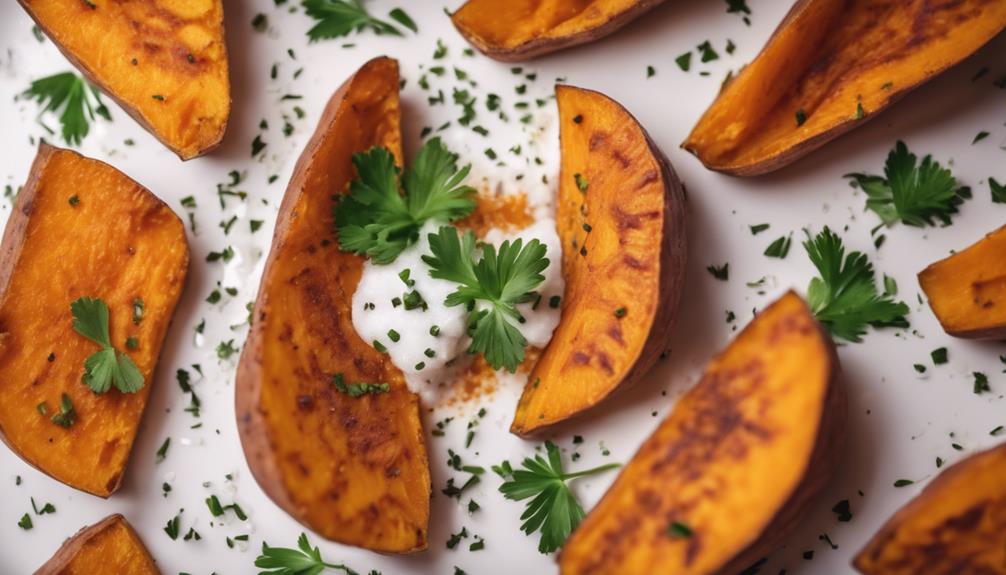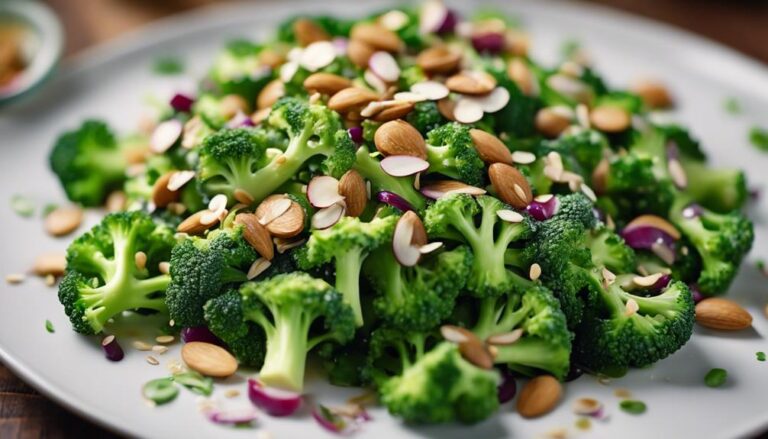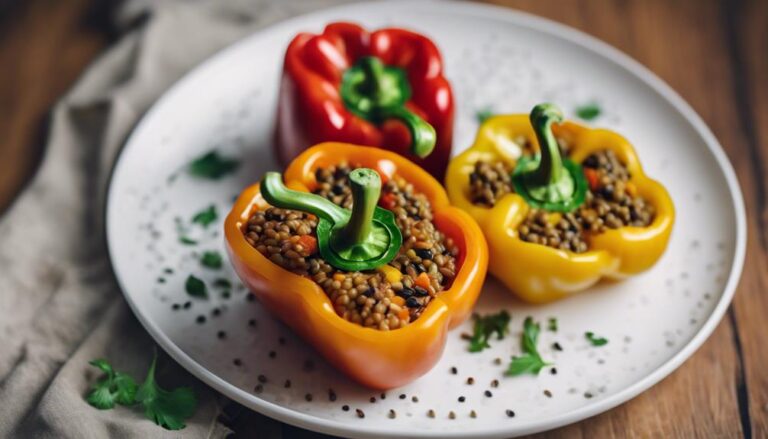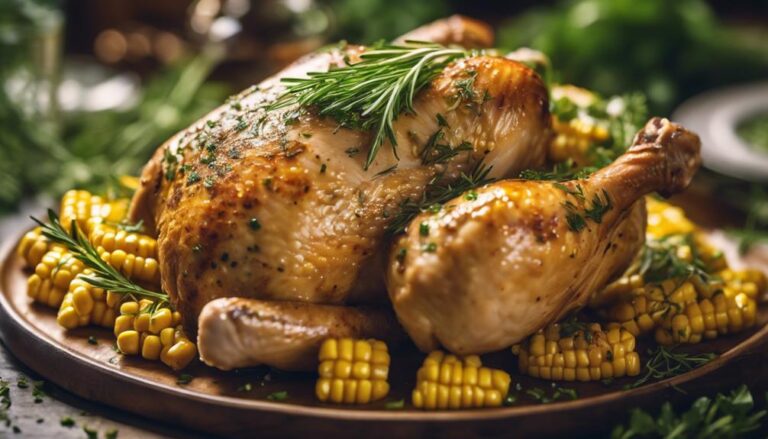Sous Vide Sweet Potato Wedges
For perfectly cooked sweet potato wedges that are tender, flavorful, and rich in nutrients, sous vide is the way to go. Choose your favorite sweet potato variety. Season well, vacuum-seal with precise temperature control. Cook until tender and then finish in a hot oven for that crispy exterior. Experiment with different seasonings for unique flavors. Elevate your dish with tasty dipping sauces. The sous vide method guarantees the sweet potatoes retain their natural sweetness and nutrients while offering a perfectly cooked texture. Enhance your culinary skills by exploring various flavor profiles with extended cooking times.
What You Will Learn Here
- Sous vide method ensures even cooking and tender texture for sweet potato wedges.
- Precise temperature control preserves natural sweetness and nutrients.
- Extended cooking times enhance flavor development without compromising texture.
- Experiment with seasoning and dips to complement the sweet potato's taste.
- Sous vide cooking guarantees foolproof results and optimal flavor profile.
Origins of Sweet Potatoes
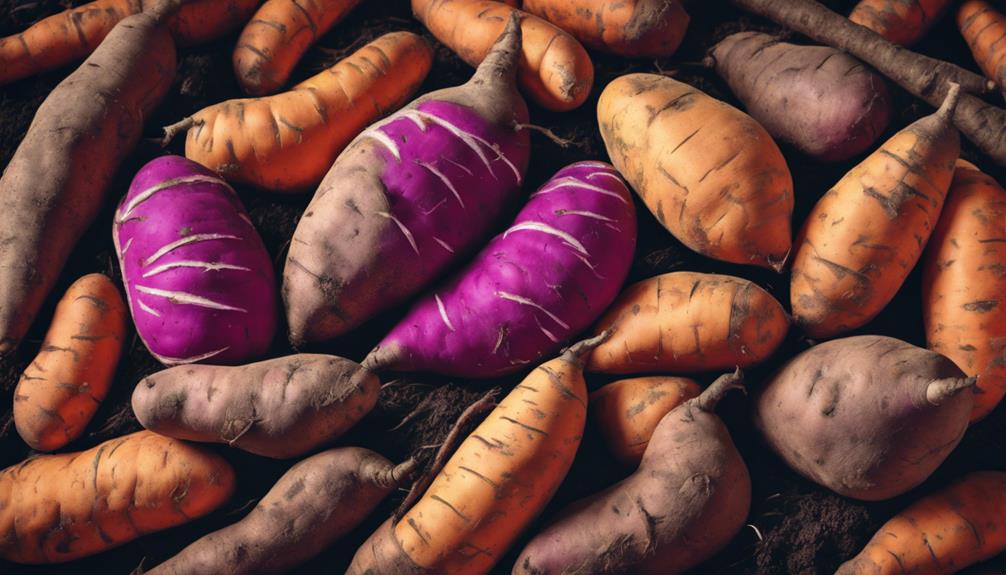
Sweet potatoes, originating in Central and South America, have a rich history dating back thousands of years. These tuberous roots aren't only delicious but also pack a nutritional punch, being high in fiber, vitamins, and minerals.
Their versatility in the culinary world makes them a staple ingredient in various dishes worldwide.
Sweet Potato History
Originating from the tropical regions of the Americas, the sweet potato has a rich history that dates back thousands of years. Sweet potato cultivation has been a significant part of various cultures, with festivals dedicated to celebrating this versatile tuber. Throughout history, sweet potatoes have been cultivated for their nutritional value and adaptability to different climates.
Sweet potato festivals, common in many regions, highlight the cultural importance of this crop. The sweet potato's journey from its origins in the Americas to becoming a global food staple showcases its resilience and popularity. Understanding the historical significance of sweet potatoes sheds light on the deep-rooted connection between this tuber and human civilization, making it a fascinating subject for exploration.
Nutritional Benefits
The historical cultivation and widespread adoption of sweet potatoes can be attributed to their rich nutritional profile and adaptability to various climates, making them a valuable food source across different cultures.
Sweet potatoes offer a plethora of health benefits, being high in fiber, vitamins A and C, and antioxidants. Their versatility in cooking techniques allows for a range of recipe variations, from savory dishes like sweet potato wedges seasoned with paprika to sweet treats like mashed sweet potatoes with a hint of cinnamon.
The flavor profiles of sweet potatoes can be enhanced through various cooking methods, such as roasting, boiling, or sous vide, providing a canvas for culinary innovation while preserving their nutritional value.
Culinary Versatility
With a rich history spanning centuries, the culinary versatility of sweet potatoes can be traced back to their origins in different regions.
Sweet potatoes, originating in Central and South America, have been integral to various culinary techniques worldwide. Their adaptability to different cooking methods such as roasting, boiling, or even sous vide, showcases their versatility.
The flavor profiles of sweet potatoes vary depending on the cooking technique employed. Roasting enhances their natural sweetness, while boiling may result in a softer texture with subtle flavors. Sous vide cooking preserves the sweet potatoes' nutrients and intensifies their flavors, making them an excellent choice for culinary experimentation.
Understanding the origins of sweet potatoes provides insight into their diverse applications in modern cuisine.
Sweet Potato Varieties
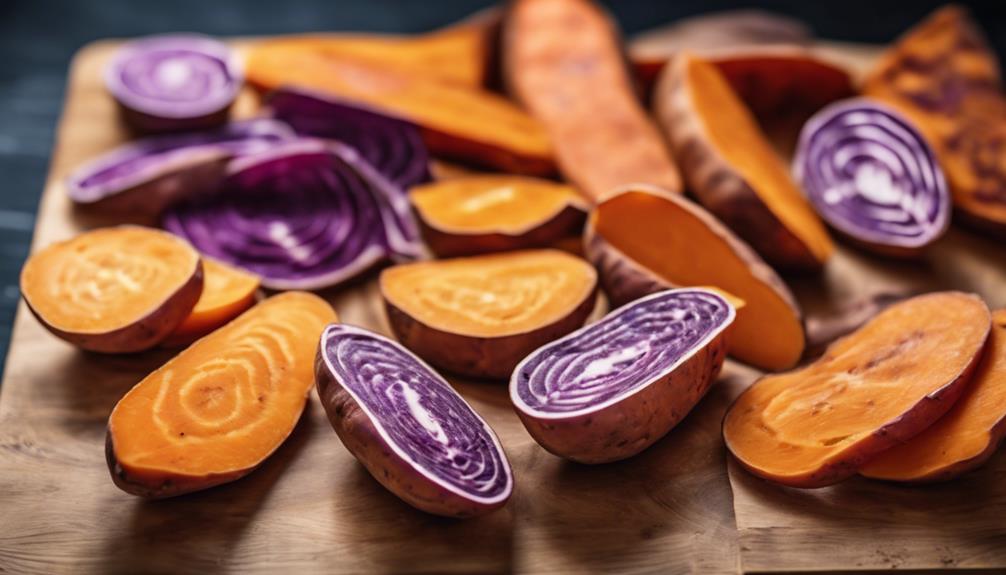
Among the various types of sweet potatoes available, some popular varieties include Beauregard, Jewel, and Garnet. Each type offers a unique flavor profile and texture, making them suitable for different culinary applications. When choosing sweet potatoes for your dishes, consider the following:
- Beauregard: Known for its vibrant orange flesh and sweet taste, Beauregard sweet potatoes are versatile and work well in both savory and sweet dishes.
- Jewel: With its deep orange color and moist texture, Jewel sweet potatoes are ideal for mashing or baking, adding a rich flavor to your recipes.
- Garnet: Garnet sweet potatoes have a reddish skin and a sweet, earthy flavor, making them perfect for roasting or grilling to enhance their natural sweetness.
- Japanese Sweet Potatoes: These sweet potatoes have a purple skin and a white flesh, offering a slightly drier texture and a nutty flavor that pairs well with various seasonings and cooking methods.
Experimenting with these different sweet potato varieties can elevate your culinary creations, allowing you to explore new cooking techniques and flavor combinations.
Tasty Sweet Potato Dishes
You can explore a variety of tasty sweet potato dishes like savory sweet potato fries, a mouth-watering sweet potato nacho bake, and crispy sweet potato chips.
These dishes offer a delightful blend of flavors and textures, showcasing the versatility of sweet potatoes in culinary creations.
Consider trying out these recipes to experience the deliciousness of sweet potatoes in different forms.
Savory Sweet Potato Fries
For peak flavor and texture, consider seasoning your sweet potato fries with a blend of herbs and spices before cooking them to golden perfection. To enhance your savory sweet potato fries, follow these innovative steps:
- Seasoning Perfection: Guarantee an even coating of flavorful seasoning on each fry.
- Preparation Precision: Cut the sweet potatoes uniformly for consistent cooking.
- Cooking Innovation: Experiment with different cooking techniques like air frying or baking for varied textures.
- Serving Creativity: Pair your savory sweet potato fries with unique dipping sauces for a delightful culinary experience.
Sweet Potato Nacho Bake
Incorporating a medley of sweet potatoes, savory toppings, and a cheesy finish results in a delectable Sweet Potato Nacho Bake, a standout among tasty sweet potato dishes. When preparing this innovative dish, consider the following:
- Nacho Toppings: Experiment with various toppings like black beans, diced tomatoes, jalapeños, and cilantro for a burst of flavors.
- Baking Techniques: Opt for a baking method that guarantees the sweet potatoes are perfectly cooked and the cheese is melted to perfection.
- Layering: Strategically layer the sweet potatoes, toppings, and cheese to ensure even distribution of flavors.
- Serving Suggestions: Serve the Sweet Potato Nacho Bake with a dollop of sour cream or a side of guacamole for added indulgence.
This Sweet Potato Nacho Bake is a delightful twist on classic nachos that's sure to impress your taste buds.
Crispy Sweet Potato Chips
After relishing the flavorful Sweet Potato Nacho Bake, delving into the realm of Tasty Sweet Potato Dishes brings us to the area of Crispy Sweet Potato Chips. When striving for the perfect batch of crispy sweet potato chips, mastering baking techniques, flavor pairing, cooking time, and temperature control is essential. Here are some key points to ponder:
- Thin Slices: Cutting the sweet potatoes into thin, uniform slices guarantees even cooking.
- Oil Coating: Lightly coat the slices with oil to help achieve a crispy texture.
- Low and Slow: Baking at a lower temperature for a longer time helps dehydrate the sweet potatoes for that satisfying crunch.
- Seasoning: Experiment with various seasonings like rosemary, garlic powder, or paprika to enhance the flavor profile.
Sweet Potato Wedges Texture
To achieve ideal texture when preparing sweet potato wedges, focus on achieving a crispy outer layer while maintaining a soft interior texture.
The key lies in balancing the cooking time and temperature to guarantee the desired contrast in textures.
Additionally, consider the level of seasoning absorption to enhance the overall flavor profile of the sweet potato wedges.
Crispy Outer Layer
Achieve a crispy outer layer on your sweet potato wedges by adjusting the cooking temperature and duration during the sous vide process. To enhance the crispiness, consider using different baking techniques like finishing the wedges in a hot oven or crisping them up in a skillet post-sous vide. Experiment with various flavor profiles by adding spices or a sprinkle of parmesan cheese before the final crisping step.
Essential cooking times are vital; too long may result in a dry texture, while too short may leave the wedges undercooked. Pair your crispy sweet potato wedges with complementary dipping sauces like aioli or a tangy yogurt-based dip to elevate the overall taste experience.
Adjusting these variables will help you achieve the desired crispy texture while maintaining the sweet potato's natural flavor.
Soft Interior Texture
For a soft interior texture in your sweet potato wedges, precise control over the sous vide temperature and time is crucial. Achieving this texture involves using cooking techniques that maintain the sweet potato's natural moisture while gradually breaking down its starches.
By setting the sous vide machine to a specific temperature and time combination, you can guarantee that the sweet potato wedges cook evenly and reach the desired softness without becoming mushy. This method allows for a consistent outcome and prevents overcooking, resulting in a perfectly tender interior.
Pairing this technique with flavorful seasoning enhances the taste profile of the sweet potato wedges, creating a harmonious balance between texture and flavor that elevates your dish to a new level of culinary delight.
Seasoning Absorption Level
Ensuring ideal seasoning absorption in sweet potato wedges is essential to enhancing their texture profile through a balanced infusion of flavors.
To achieve the best seasoning, consider utilizing various seasoning techniques such as dry rubs, marinades, or brines. Each method offers unique opportunities to enhance flavor profiles by allowing the seasonings to penetrate the sweet potato wedges evenly.
When selecting seasoning techniques, it's important to align them with your desired flavor outcome. Additionally, the cooking method employed greatly impacts the seasoning absorption level.
For instance, sous vide cooking provides a controlled environment that ensures the sweet potato wedges absorb flavors consistently throughout the cooking process.
Final Thoughts
In conclusion, considering the consistent tenderness and enhanced flavor achieved through the precise sous vide cooking method, these sweet potato wedges present an exceptional option for a flavorful side dish. The sous vide technique allows for precise temperature control, ensuring that the sweet potatoes are cooked evenly from edge to center. This method also helps in retaining the natural sweetness and nutrients of the sweet potatoes, enhancing their overall flavor profile.
When it comes to cooking times, sous vide offers a foolproof way to achieve perfect results every time. By cooking the sweet potato wedges in a water bath at a controlled temperature for an extended period, the flavors have ample time to develop and infuse into the potatoes thoroughly. This slow and steady cooking process results in a tender yet firm texture that's difficult to achieve through traditional methods.
Frequently Asked Questions
Can I Use Regular Potatoes Instead of Sweet Potatoes for This Recipe?
Yes, you can use regular potatoes instead of sweet potatoes for this recipe. The cooking techniques remain the same. Adjust for flavor differences. Sous vide guarantees precise cooking, enhancing texture and taste. Experiment with different potato alternatives for a unique twist.
How Can I Adjust the Cooking Time for Larger Sweet Potato Wedges?
When adjusting the size of your sweet potato wedges for sous vide cooking, remember to extend the cooking time to guarantee thorough heating at the specified temperature. This adjustment will help maintain the desired texture and flavor.
Are Sweet Potato Wedges Suitable for Freezing and Reheating Later?
When freezing sweet potato wedges, make sure they are fully cooled before placing in airtight containers for storage. To reheat, use an oven at 375°F for best texture retention. This method helps maintain flavor and prevents excessive moisture loss.
Can I Add Different Seasonings or Spices to the Sweet Potato Wedges?
Experiment with various flavorful combinations to enhance your sweet potato wedges. Adjust seasonings to suit your taste preferences. Try different cooking techniques for varying textures. Seasoning experimentation can elevate your dish to new heights.
What Are Some Creative Serving Suggestions for Sweet Potato Wedges?
For creative presentation ideas, consider arranging sweet potato wedges in a spiral pattern on a plate. Plating techniques like layering them with fresh herbs can enhance aesthetics. Flavor pairings with honey or cinnamon and garnish options like toasted pecans can elevate the dish.
Conclusion
To sum up, sous vide sweet potato wedges offer a unique and delicious way to enjoy this versatile root vegetable. By cooking them in a controlled water bath at a precise temperature, you can achieve a perfect texture that's tender on the inside and crispy on the outside.
Experiment with different seasonings and cooking times to customize the flavor to your liking. Elevate your sweet potato game with this innovative cooking method.
